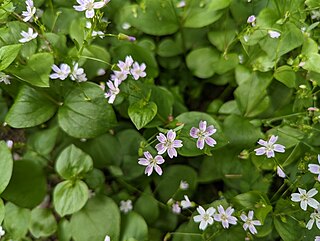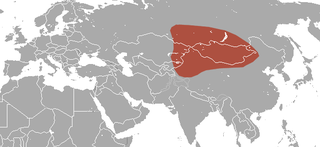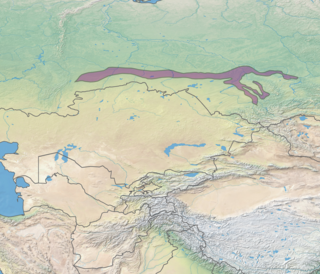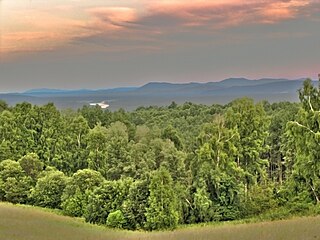
The Siberian thrush is a member of the thrush family, Turdidae. The genus name Geokichla comes from Ancient Greek geo-, "ground-" and kikhle, " thrush". The specific sibirica is Latin for Siberia.

Pinus sibirica, or Siberian pine, in the family Pinaceae is a species of pine tree that occurs in Siberia from 58°E in the Ural Mountains east to 126°E in the Stanovoy Range in southern Sakha Republic, and from Igarka at 68°N in the lower Yenisei valley, south to 45°N in central Mongolia.

Larix sibirica, the Siberian larch or Russian larch, is a frost-hardy tree native to western Russia, from close to the Finnish border east to the Yenisei valley in central Siberia, where it hybridises with the Dahurian larch L. gmelinii of eastern Siberia; the hybrid is known as Larix × czekanowskii.

Abies sibirica, the Siberian fir, is a coniferous evergreen tree native to the taiga east of the Volga River and south of 67°40' North latitude in Siberia through Turkestan, northeast Xinjiang, Mongolia and Heilongjiang.

The Siberian weasel or kolonok, is a medium-sized weasel native to Asia, where it is widely distributed and inhabits various forest habitats and open areas. It is therefore listed as Least Concern on the IUCN Red List.

Claytonia sibirica is a flowering plant in the family Montiaceae, commonly known as pink purslane, candy flower, Siberian spring beauty or Siberian miner's lettuce. A synonym is Montia sibirica. It is native to Aleutian Is. and western North America and has been introduced into parts of Europe and Scandinavia.

Iris sibirica, commonly known as Siberian iris or Siberian flag, is a species of flowering plant in the family Iridaceae. It is a rhizomatous herbaceous perennial, from Europe and Central Asia. It has long green grass-like leaves, tall stem, 2–5 violet-blue, to blue, and occasionally white flowers. It is cultivated as an ornamental plant in temperate regions.

Eurybia sibirica, commonly known as the Siberian aster or arctic aster, is an herbaceous perennial native to north western North America and northern Eurasia. It is found largely in open areas of subarctic boreal forests, though it is also found in a wide variety of habitats in the region. It is similar in appearance to Eurybia merita, but their ranges overlap only near the border between the US and Canada, where E. sibirica is generally found at higher elevations.

The Siberian ibex, also known using regionalized names including Altai ibex,Asian ibex, Central Asian ibex, Gobi ibex, Himalayan ibex, Mongolian ibex or Tian Shan ibex, is a polytypic species of ibex, a wild relative of goats and sheep. It lives in Central Asia, and is, by far, the most widely-distributed species in the genus Capra. In terms of population stability, Siberian ibex are currently ranked as Near Threatened, mostly due to over-hunting, low densities and overall decline; still, reliable data is minimal and difficult to come by, in addition to the animals’ expansive natural range, so accurate observations are still scant. The Siberian ibex has, formerly, been treated as a subspecies of the Eurasian Alpine ibex, and whether or not it is a single species or a complex of distinct units that stand out as genetically-distinct is still not entirely clear. The Siberian ibex is the longest and heaviest member of the genus Capra, though its shoulder height is slightly surpassed by the markhor.

The dark-sided flycatcher is a small passerine bird belonging to the genus Muscicapa in the Old World flycatcher family Muscicapidae. It has a wide breeding distribution in the East Palearctic with northern birds migrating south for the winter. It is also known as the Siberian flycatcher or sooty flycatcher, the latter name is also used for the sooty flycatcher of Africa.

The Siberian shrew is a species of mammal in the family Soricidae. It is found in Russia, and possibly China and Mongolia.

The Japanese weasel is a carnivorous mammal belonging to the genus Mustela in the family Mustelidae. The most closely related Mustela species is the Siberian weasel. Its taxonomic species name, itatsi, is based on the Japanese word for weasel, itachi (イタチ). It is native to Japan where it occurs on the islands of Honshū, Kyūshū and Shikoku. It has been introduced to Hokkaidō and the Ryukyu Islands to control rodents and has also been introduced to Sakhalin Island in Russia.

Cosmopterix is a large genus of moth in the family Cosmopterigidae.
Cosmopterix argentitegulella is a moth of the family Cosmopterigidae. It is known from Russia and China (Jiangxi).
Cosmopterix geminella is a moth of the family Cosmopterigidae. It is known from Russia.

Prunus sibirica, commonly known as Siberian apricot, is a species of shrub or small tree native to northern China, Korea, Mongolia, and eastern Siberia. It is classified in the rose family, Rosaceae, and is one of several species whose fruit are called apricot, although this species is rarely cultivated for its fruit. The species was named by Carl Linnaeus in 1753.

Iris ser. Sibiricae is a series of flowering plants in the genus Iris, subgenus Limniris.

The West Siberian broadleaf and mixed forests, also known as the Western Siberian hemiboreal forests, is an ecoregion in Russia. It consists of a thin band of mixed forest along the southernmost edge of the West Siberian taiga in Western Siberia, and north of the forest steppe belt. The biodiversity of the zone is the highest in Siberia, due to its transitional position between many different ecoregions. The area acts as a long corridor for migration of animals along the east-west axis. The ecoregion is in the Palearctic realm, with a Humid Continental climate. It covers 223,516 km2 (86,300 sq mi).

Salair National Park is located on the west slope of the Salair Ridge, which separates Altai Krai from Kemerovo Oblast. The low mountains are covered with coniferous forest, while the non-park surroundings to the west are steppe and forest steppe that has mostly been converted to agriculture. Because of its warm, humid summers, scientists have referred to Salair as the "rainforest of Siberia", with resulting high biodiversity and relict plants preserved from the pre-glacial period. The park was officially created in 2020; it is located in the districts of Zarinsk, Togulsky, Yeltsovsky and Soltonsky of Altai Krai.

Pinus pumila × P. sibirica is a putative hybrid of Japanese stone pine and Siberian pine. It has not yet been officially described.


















